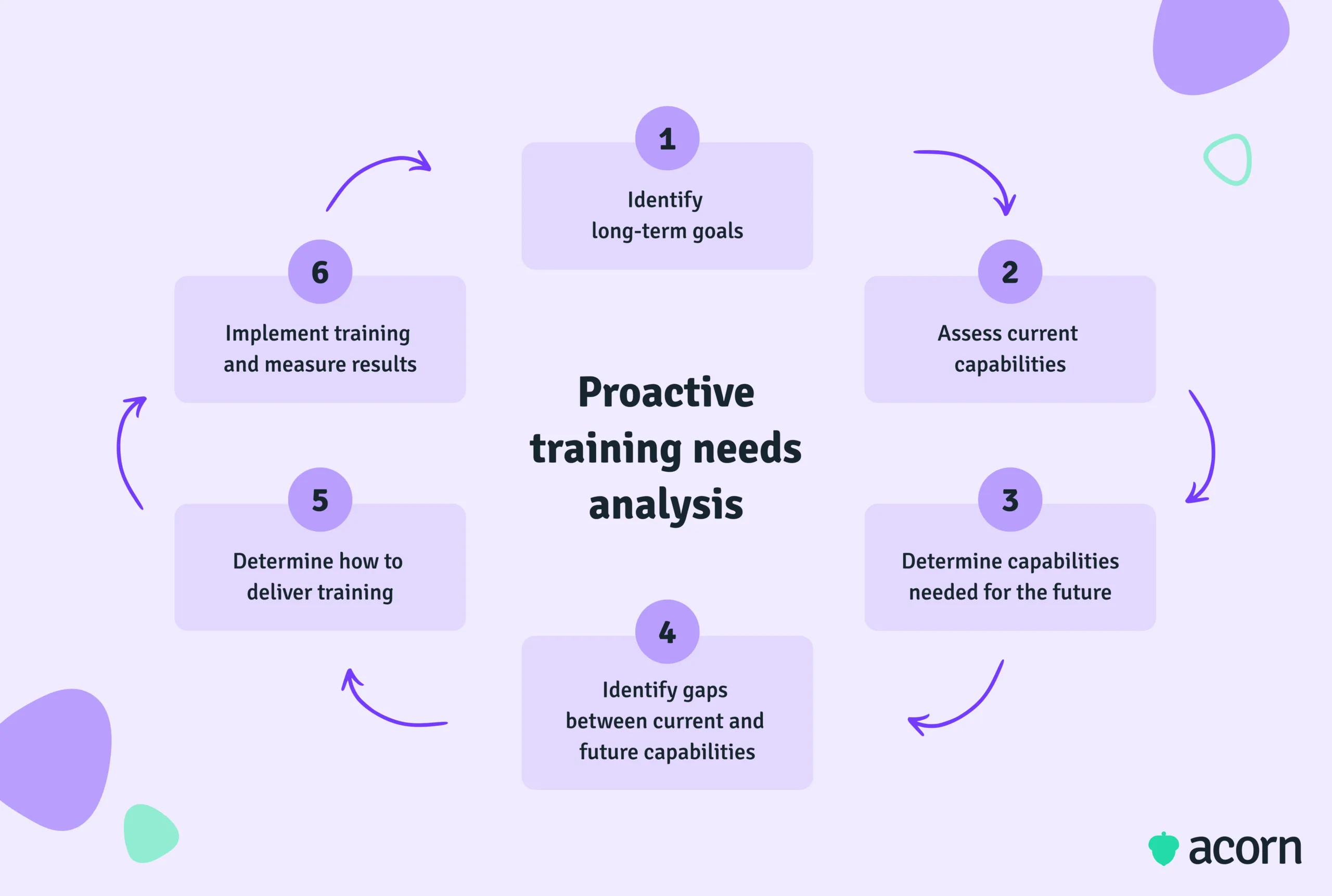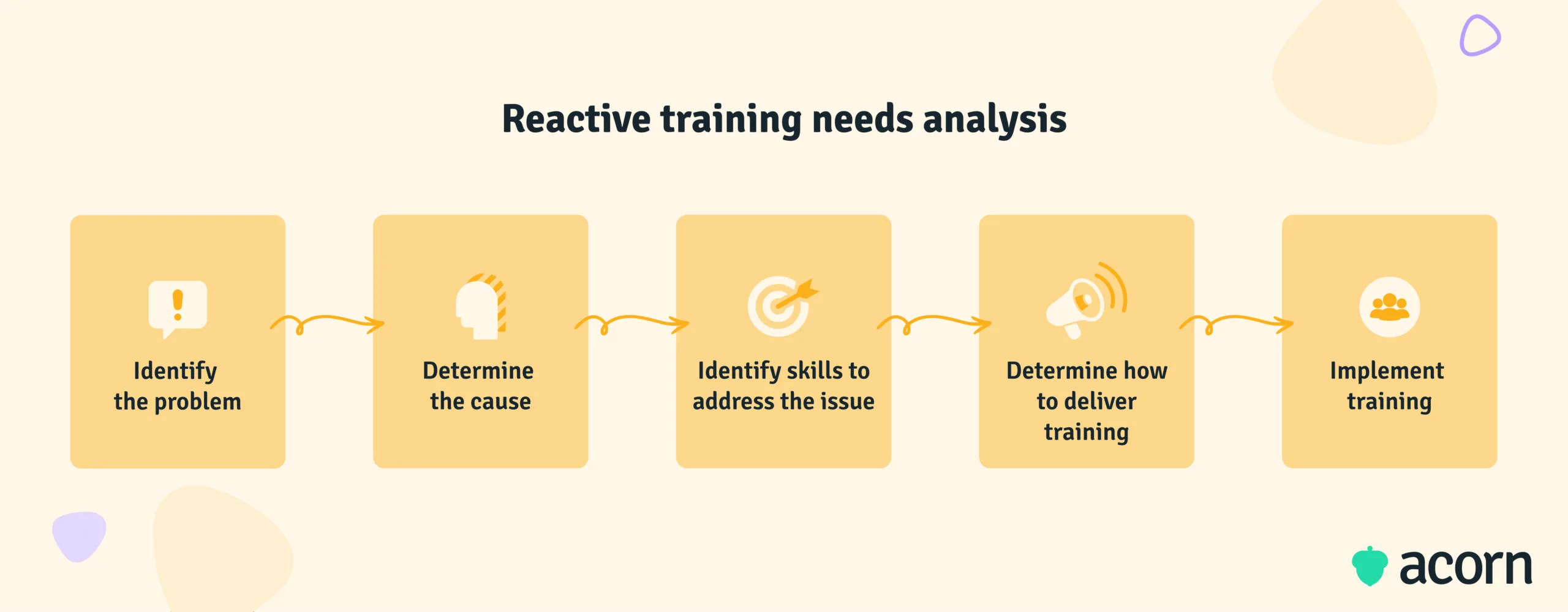How to Use a Training Needs Analysis to Determine Training Effectiveness
Reading Time:

Lead the pack with the latest in strategic L&D every month— straight to your inbox.
SubscribeSearching for gaps in your organization’s current capabilities that will deliver on goals?
You need a training needs analysis. Its whole schtick is finding training pain points and building an effective training program to address them.
In this article, we’ll dig into how a training needs analysis helps you pinpoint capability gaps, build training that actually improves performance, and connect learning to meaningful business outcomes.
What is a training needs analysis?
A training needs analysis (TNA) is a process used to identify the skills, knowledge, and abilities required to perform a job effectively and compare them to current capabilities. It’s a key tool for identifying training needs and determining the most effective way to bridge capability gaps through training.
In practice, a TNA is how you translate “we need people to perform differently” into the specific capabilities, behaviors, and learning experiences required to make it happen—without guessing or overspending.
The benefits of a training needs analysis
You can’t improve what you can’t see. A training needs analysis gives you a clear line of sight into what’s missing, and enables you to provide training that’ll move the needle.
That gives you a few critical advantages.
Firstly, it nets you better performance across the business. In 2021, Gartner said 58% of the workforce didn’t have the skills required to do their jobs. In 2023, WEF found six in 10 employees will need training for new roles by 2027, but only half will have access to it. LinkedIn Learning notes that the capabilities required for jobs will change 65% by 2030, thanks to AI. Lacking the ability to see what you need puts you way behind the eight ball in the fight for future talent and competitive advantage. A TNA gives you hard evidence of what capabilities matter, where the gaps sit, and what training will actually move the needle on performance.
Secondly, better performance means better outcomes means better ROI. Training is expensive when it’s misaligned. A TNA shows you exactly where to invest by tying spend to behavioral change, not assumptions or stakeholder preferences. You stop reacting to opinions about what training people need and start directing investment based on evidence. It becomes easier to push back, easier to prove impact, and far easier to show how learning links directly to performance.
Third, it strengthens retention. Employees stay longer when they see a pathway for growth, but they’re significantly more stressed when they don’t feel equipped to succeed in their role. A TNA ensures your development efforts are targeted and meaningful, so people can see how learning connects what they’re doing today to opportunities tomorrow.
Fourth, you can show training effectiveness. By assessing the capabilities both before and after training, you’ll get an idea of how well employees have retained the required knowledge and skills for their roles, and be able to prove exactly what training programs contributed.
Finally, it keeps you compliant. Many industries rely on up-to-date certifications, licenses, or technical capabilities to operate safely and legally. A TNA can help pinpoint where compliance capabilities are slipping. That means less wasted time, fewer surprises, and a workforce that meets regulatory requirements with less manual admin.
Proactive vs reactive training needs analysis
There are two ways to approach a training needs analysis: proactively or reactively.
- A proactive training needs analysis looks ahead.
- A reactive training needs analysis deals with what’s happening right now.
Most organizations default to the latter, usually because something has gone wrong and training is the quickest lever to pull. But the real value lies in combining both.
How to conduct a proactive training needs analysis
Context is king. A proactive TNA is only useful if it’s driven by what your business is actually trying to achieve. The process isn’t complicated, but it does require discipline.
- Start with the organization’s long-term goals. You aren’t just identifying a problem at hand—you’re looking at where the organization is heading and what capabilities people will need to get it there.
- Assess the capabilities your workforce has right now. Surveys, assessments, performance data, manager feedback, and work samples all help you build an honest picture of current capability. The goal is accuracy, not volume. You want evidence of how people actually perform, not how they think they perform.
- Identify the capabilities they’ll need next. This is where you fold in strategic priorities, role evolution, regulatory changes, and technology shifts (including AI reshaping job requirements).
- Run a gap analysis. In essence, a capability gap analysis uncovers the gap between what your people can do today and what the business will need them to be able to do tomorrow, providing opportunities for development.
- Determine the most effective way to provide training. This isn’t just about picking courses. Most learning happens on the job, not in a learning management system. L&D should be a mix of learning experiences, like formal training, on-the-job activities, coaching, and stretch assignments.
- Implement and measure. A proactive TNA isn’t a one-off. Once development begins, you need to track whether performance is improving and what learning helped move the needle.

Conducting a reactive training needs analysis
A reactive TNA is usually triggered when something isn’t landing the way it should: slipping productivity, quality issues, rising error rates, or a team missing targets. The goal here isn’t to build a full capability strategy; it’s to diagnose what’s actually going wrong and course correct as quickly as possible.
- Identify the problem. This could be a performance issue, a change in regulations or policies, or some other issue that has arisen in the workplace. Not “the team is struggling,” but what the struggle looks like: missed deadlines, poor customer outcomes, inconsistent quality, compliance failures.
- Determine the root cause. Once the problem or issue has been identified, the next step is to determine the root cause. Sometimes it’s lack of training. Other times, it’s poor workflows, systems, unclear expectations, or resource constraints.
- Pinpoint the capability gap. Consult with the relevant stakeholders, like SMEs and managers, here. You’re looking for:
- – Which exact capability isn’t being demonstrated (not “communication” but stakeholder negotiation, report writing, requirements gathering, etc.).
- – What proficiency level is expected versus what’s actually showing up in the work.
- – Which behaviors are missing in practice, i.e., the observable actions that show capability (e.g., not escalating risks, not validating information, skipping quality checks).
- – What evidence confirms the gap: performance data, missed KPIs, work samples, quality audits, customer feedback.
- – Whether the gap sits with an individual, the role, or the entire function.
- Determine how you’ll provide training. Once you know the root cause, you can choose the appropriate response. That might be targeted training, coaching, process changes, clearer role expectations, or a new tool. A reactive TNA keeps you from wasting time and budget on training that won’t address the real problem or cause it to fester longer.
- Implement and reassess. Reactive TNAs are short-cycle by design. Once the intervention goes live, monitor whether performance shifts through capability assessments. If you don’t see improvement, it doesn’t automatically mean capability wasn’t the issue. It could be training didn’t give people enough time to practice or environmental factors are still getting in the way.

The challenges of conducting a training needs analysis
Of course, conducting a TNA isn’t always easy. While you might come across some challenges in the process of doing a TNA, they aren’t difficult to overcome.
- Lack of buy-in from employees and managers alike. Introducing capability assessments without training on benefits can feel like you’re exposing people or creating extra work for them. The challenge for L&D isn’t running the TNA, it’s creating the psychological safety for people to be honest about what they can and can’t do. If you don’t build that trust, you’ll get surface-level input that doesn’t tell you anything useful.
- Poor data. You can’t run a meaningful TNA if you’re scraping information from old performance reviews, scattered spreadsheets, anecdotal manager feedback, or tools that don’t talk to each other. The result is a blurry picture that leads to blurry decisions. To get an accurate read on capability, you need a single source of truth—assessments, evidence, and role expectations stored in one place.
- Confusing symptoms with causes. Poor quality work doesn’t automatically mean people lack the capability—it might be workload, unclear standards, broken processes, or the wrong tools. Without careful diagnosis, you risk prescribing training that can’t fix the real problem.
- Competing priorities and limited bandwidth. Leaders want results fast. Teams are stretched. L&D is juggling everything from compliance to onboarding. Running a TNA takes coordination across a lot of stakeholders, and it’s easy for the process to stall when people don’t see immediate payoff. That’s why clarity around the purpose and expected outcomes is essential, otherwise, all TNAs are reactive.
What are the risks of not doing a training needs analysis at all?
Regardless of challenges, there are risks if you skip a training needs analysis altogether.
Skipping a TNA doesn’t save time or bureaucracy. It just delays the moment you have to deal with capability issues that have already taken root. The first risk is the most obvious: you miss gaps entirely. When you overlook gaps in how work literally gets done, they fester quietly in slower delivery, inconsistent quality, unnecessary rework, poor culture, and avoidable errors. By the time performance metrics start to dip, the gap has already grown costly.
The second risk is misdiagnosing what’s actually going wrong. Without a TNA, generic training tends to become the reflex solution to every issue—even if the root cause is unclear expectations, broken processes, or role design. That’s how organizations end up investing in programs (sometimes between $250,000 and millions, our research found) that feel busy but don’t change anything, while the real blockers stay untouched.
There’s also a strategic cost. Capability requirements shift faster than most organizations update their development plans. When you’re not actively checking where your workforce stands today, it’s almost impossible to prepare them for where the business is heading. Transformation slows, priorities drift and teams end up reacting to pressures they should have been equipped for months earlier.
And then there’s the impact on your people. When development feels generic or disconnected from what they actually need to succeed, employees start to lose confidence in the organization’s ability to support them. While 94% of employees are more likely to stay with an organisation if offered training opportunities, many are 50% more likely to look for employment elsewhere without support from managers, and ten times more likely to look for a new job if they feel their skills aren’t being put to good use.
They’re not disengaging because they dislike learning; they’re disengaging because they don’t see a meaningful path forward. Without a clear understanding of capability needs, it’s difficult to build experiences that help people grow, and your EVP quietly erodes.
Key takeaways
A training needs analysis isn’t just a box-ticking exercise, but how you get a clear, objective view of the capabilities your workforce actually has, and the ones they’ll need next.
- A proactive TNA helps you stay ahead of shifts in roles, technology, and strategic priorities.
- A reactive TNA helps you diagnose what’s driving performance issues in the moment, so you aren’t relying on guesses or generic training.
Used together, they give you a single source of truth about where capability gaps sit and how to close them. And when you connect that analysis to a system that can operationalize it—mapping capabilities to roles and learning—the TNA becomes more than insight. It becomes action.